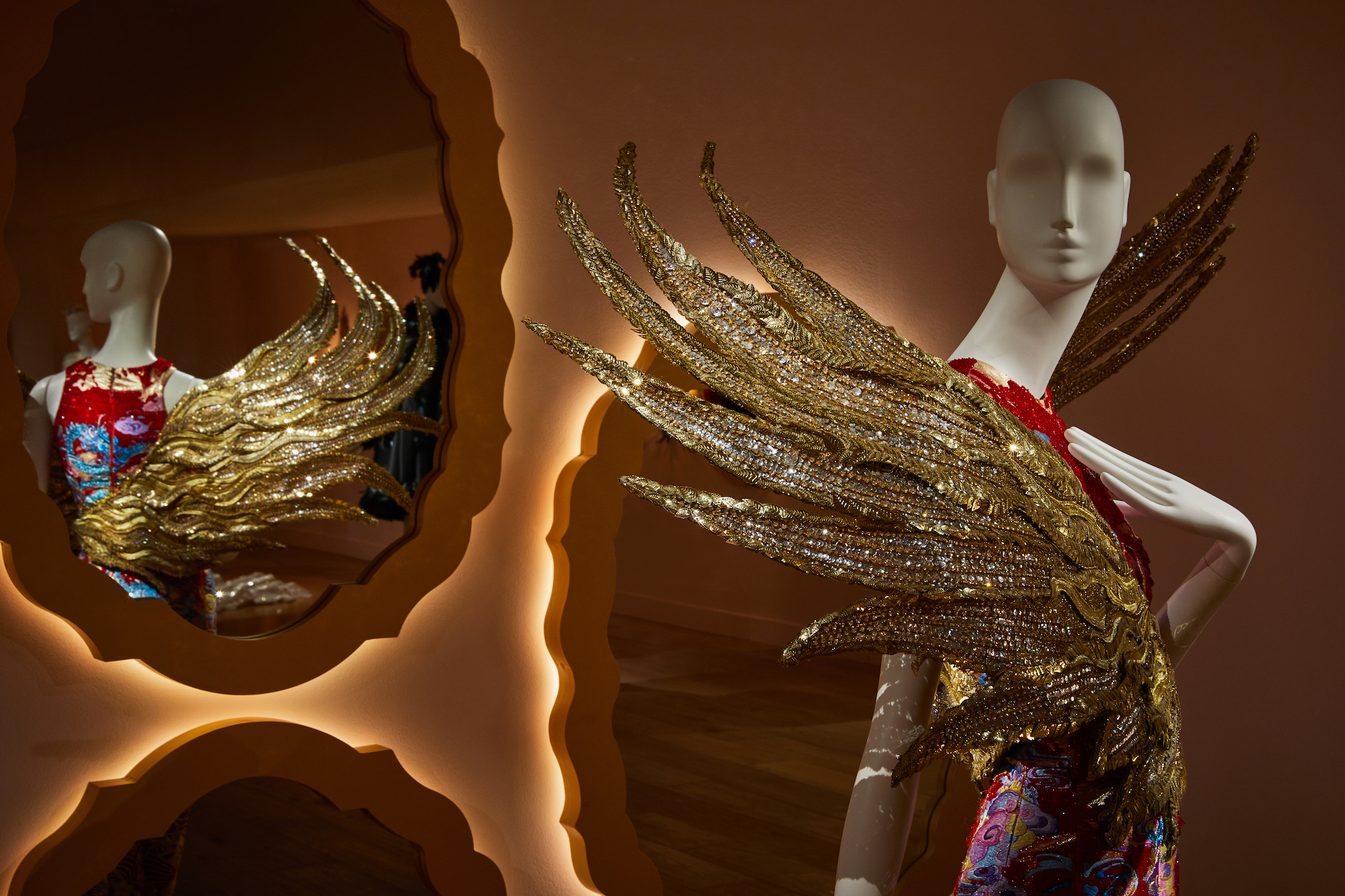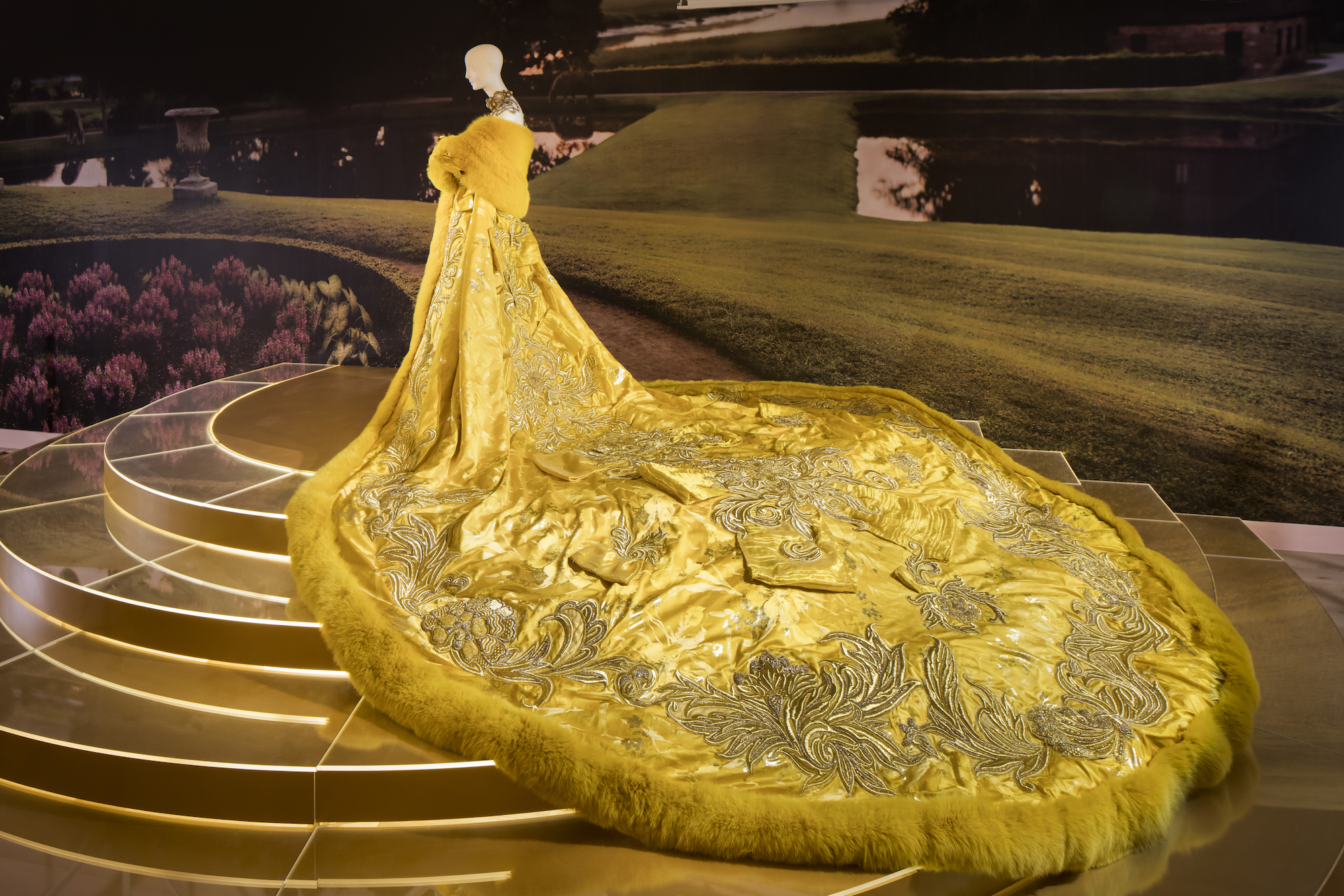Exhibition Review: Guo Pei: Couture Beyond
SCAD FASH Museum of Fashion + Film (Atlanta), September 7, 2017 – March 4, 2018
There’s something to be said about fashion designers who eschew the minimalist aesthetic that permeates contemporary life. To do away with the restrained and discreet in favor of the bold and opulent seems almost irresponsible in today’s climate, speaking both politically and environmentally. Designer Guo Pei, however, is not afraid to go there. In Guo Pei: Couture Beyond, the first U.S. solo retrospective exhibition of her illustrious career as one of the doyennes of Chinese fashion, visitors of the Savannah College of Art and Design’s SCAD FASH Museum of Fashion + Film are introduced to a designer whose oeuvre is more maximal than minimal, more historical than current, and is – most importantly – unapologetically luxurious.
Born in the late 1960s in communist China, it is possible that the uniformity of Guo’s youth propelled her interest in fashion. Guo established her own atelier in 1997, and soon found herself as the star of Chinese fashion. It was with the Costume Institute’s famed Met Ball in 2015, however, that Guo arrived on the world stage. Superstar singer Rihanna took to the red carpet in a golden silk cloak trimmed with sumptuous fox fur weighing in at a whopping fifty-five pounds, complete with four attendants to carry its larger-than-life train. The look instantly captured the attention of the style set, and Guo was heralded as fashion’s best kept secret. In 2016, the designer was invited to join the Chambre Syndicale de la Haute Couture, and has since shown in Paris during Haute Couture week to much acclaim.
Showcasing more than forty of her gowns from the past ten years, Guo Pei: Couture Beyond paints the portrait of an artist who is referencing her own Chinese background as much as she is a fantastical dream world where exquisite embroidery, vertiginous shoes, and luxurious fabrics reign supreme.
Though a relatively expansive space, the museum gallery recreates the interior of an intimate boudoir. Dimly lit, save for a gargantuan chandelier that dominates the center of the exhibition, the space seems to ask the viewer to come close – almost too close – in order to appreciate the intricate details sewn into every garment on view. Framed mirrors line the walls, offering new angles and unexpected perspectives with which to view the works.
There is one aspect of traditional exhibition design that is noticeably absent – object labels. In order to identify any information about the works on display, museum visitors must use their smartphones to navigate an accompanying website where they can find work details and additional anecdotes. I found the omission of physical labels in the space to be a notable design flaw that detracts from the experience of viewing the works, and further speaks to a larger discourse taking place within the museum field regarding the role of technology within institutions.
In 2014, the Costume Institute presented (the similarly titled) Charles James: Beyond Fashion, in which technology was used brilliantly to give museum-visitors a glimpse into not just the cultural history of the works on display, but even highlights how the garments were constructed. Stationary touchscreens, and even robotic arms equipped with spotlights, lasers, and cameras showed an exciting future for exhibition design – of how technology could be used within the museum in novel yet effective ways.
The SCAD FASH Museum clearly aims to use technology in an equally original way, but engaging with a smartphone for much of today’s generation of increasingly connected young people – myself included – strikes me as regressive and antithetical to the mission of a museum. When given the unique opportunity to interact with and observe objects in person, in three dimensions rather than two, it seems shameful to make viewers turn to their phone screens to get the complete exhibition experience.
That is not to say that this approach is without any benefits. The lack of labels suggests that specific details about when a work was designed, or the titles of the specific collections from which they come from, don’t matter when the clothes are this extravagant. The technique and the couture craftsmanship do not need to be explained or theorized to be appreciated; they speak for themselves.
If nothing else, Couture Beyond is a study in ornate, fanciful luxury. The fabrics are decadent, the embroidery is nothing short of spectacular, and Guo’s devotion to romanticism is more than evident. The designer, who now employs ateliers in both Beijing and Paris, has harkened back to an era of unrestrained extravagance. Her designs speak not only to an ardent need and desire by today’s fashion cognoscenti for bold and unabashed displays of color, wealth, and superfluity, but more importantly it speaks to the greater history of couture. The masterful craftsmanship of each garment is breathtaking to view in person. Threads spun with gold and silver act as a backdrop to jewels and crystals that take center-stage. Fabric is manipulated into the most delicate and intricate pleats and then layered to stunning effect. The shoes tower on tall platforms, covered in beads, glass, and even more gold-spun thread.
The immediate focal point of the exhibition is, no surprise, the golden cloak worn by Rihanna to the Met Ball. A mannequin is posed on the stairs with the plush fur-trimmed train trailing behind her. The garment is part of Guo’s 2010 collection “One Thousand and Two Nights,” and three additional garments from the collection are prominently featured in the exhibition, including a gown hand-painted to resemble blue and white fine bone china that was also included in the Costume Institute’s 2015 exhibition, China: Through the Looking Glass. Both of these gowns remark not only upon the vibrant history of Chinese craftspeople, but also its interactions with the history of western fashion. Couturier Paul Poiret famously hosted his legendary “Thousand and Second Night Party” in 1911, forcing party guests to don eastern-inspired costume in order to attend. In many ways, by naming her collection in a similar fashion, Guo has, a century later, seemingly reclaimed her eastern heritage back from the clutches of the French fashion system.
The exhibition continues with equally elaborate gown after gown, each a stunning triumph for the art of dressmaking. Particular standouts include a dress from the 2016 “Courtyard” collection whose fabric bends light marvelously, and a silk gown whose over-the-top fur-trimmed train, overwhelming embroidery, and stylized crown, in one glance, takes the breath away.
Despite the brilliant garments on view, the question begs to be asked – why Atlanta, and why the SCAD FASH Museum of Fashion + Film? For the first U.S. retrospective of her work, Guo seemingly had her pick of any city. Atlanta does not hold any cache as a major fashion capital in the United States, and to place her works so far from cities like New York and Los Angeles appears to be a deliberate choice.
However, by placing her works within the context of one of the nation's leading universities of art and design, perhaps Guo is using her platform in an even more generous context. When establishing her own ateliers, Guo searched far and wide for the finest craftspeople to execute her designs – she personally sought out the technicians who had dressed the royal family of China. Moreover, Guo trained many of her embroiderers herself. Perhaps by placing the works in an academic context, she is hoping to train the eyes of the incoming guard of young designers, artists, and creatives. An accompanying monograph will be released in April 2018.
Guo Pei: Couture Beyond is on view through March 4, 2018 at the SCAD FASH Museum of Fashion + Film in Atlanta, Georgia.





